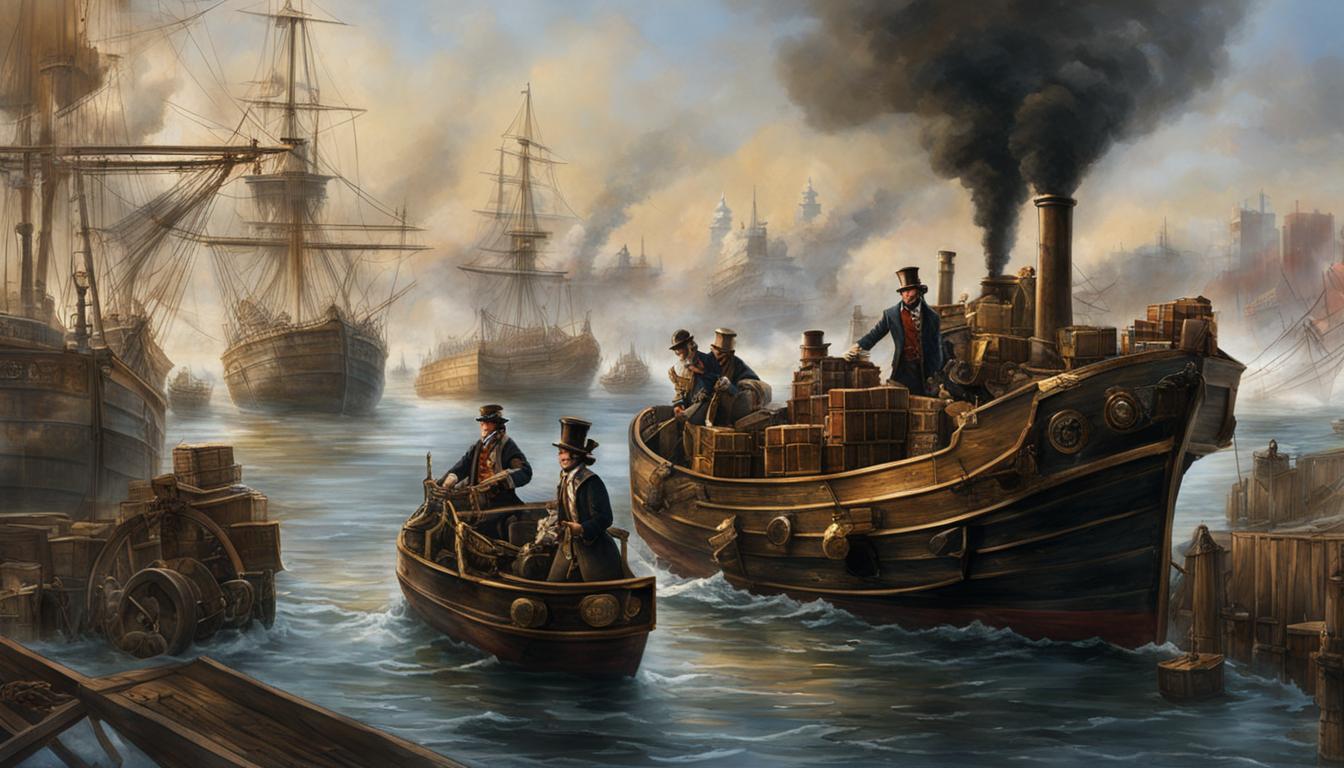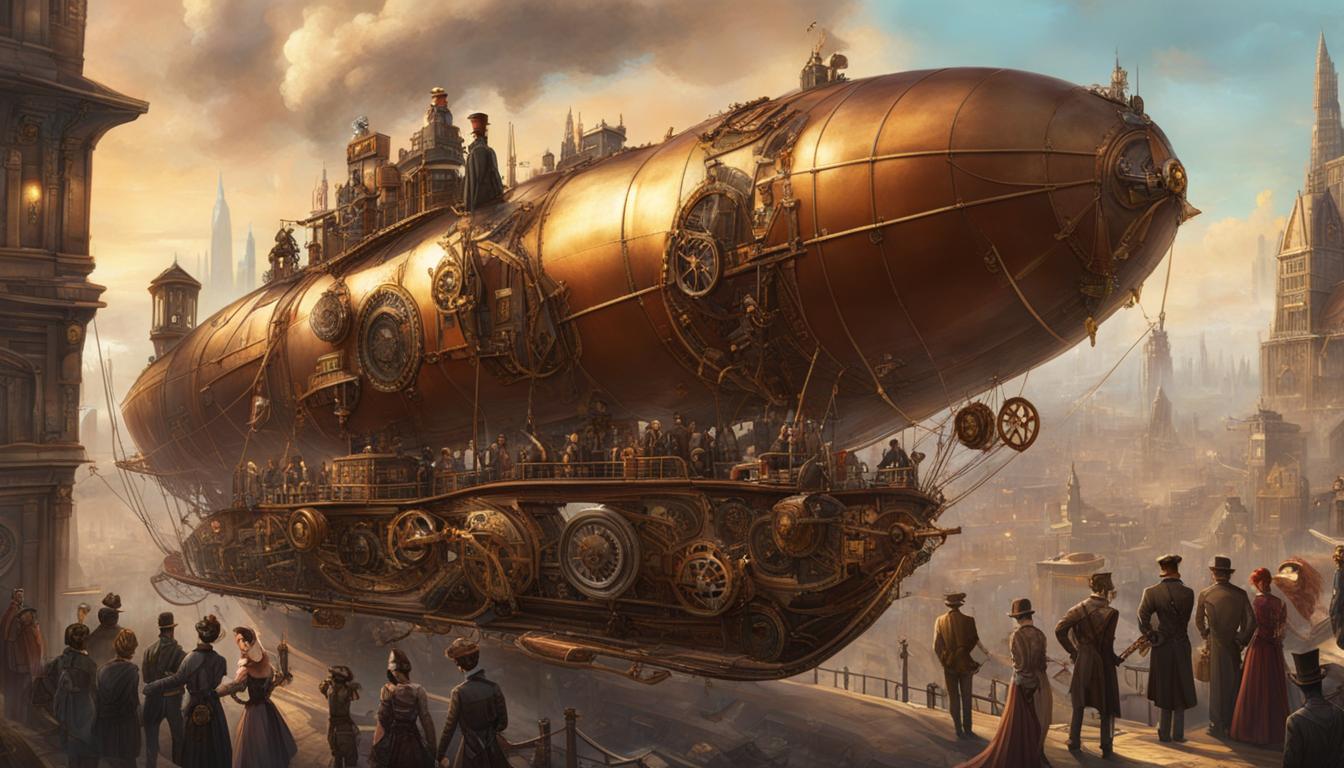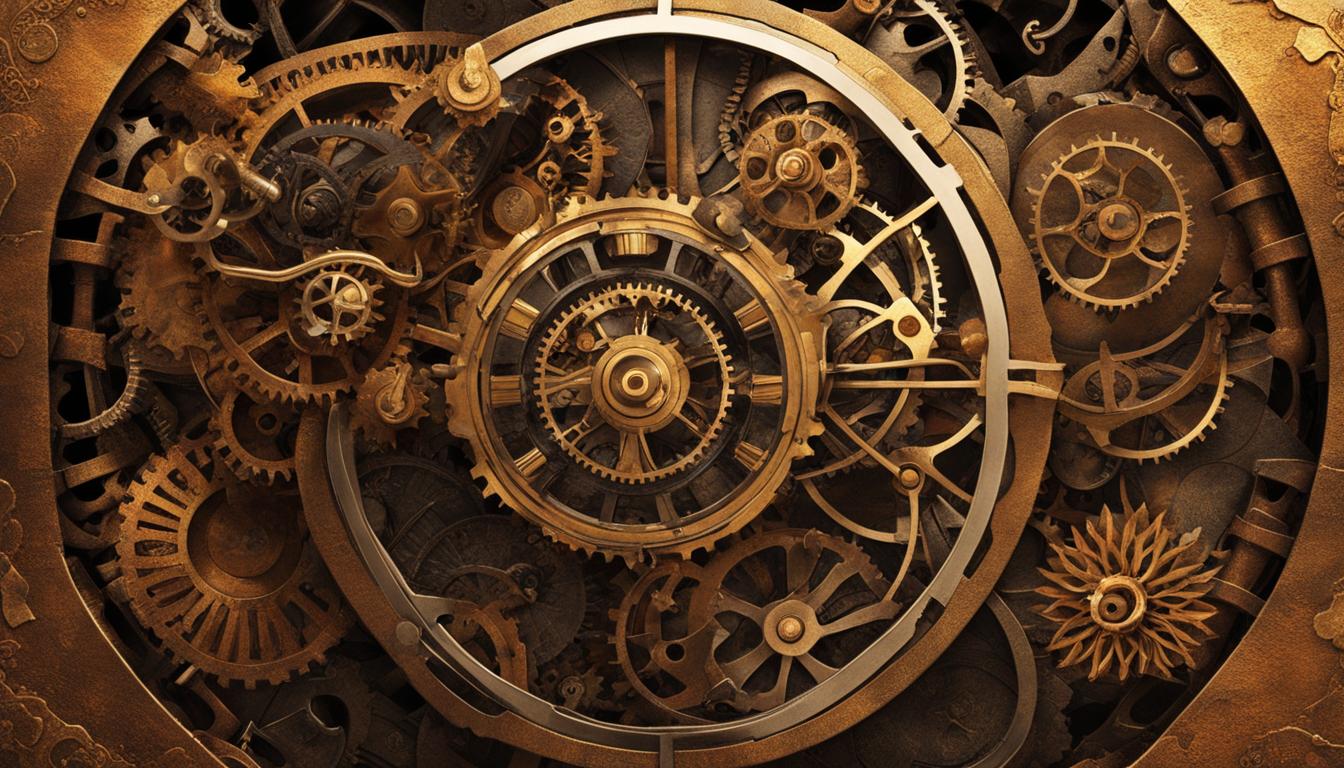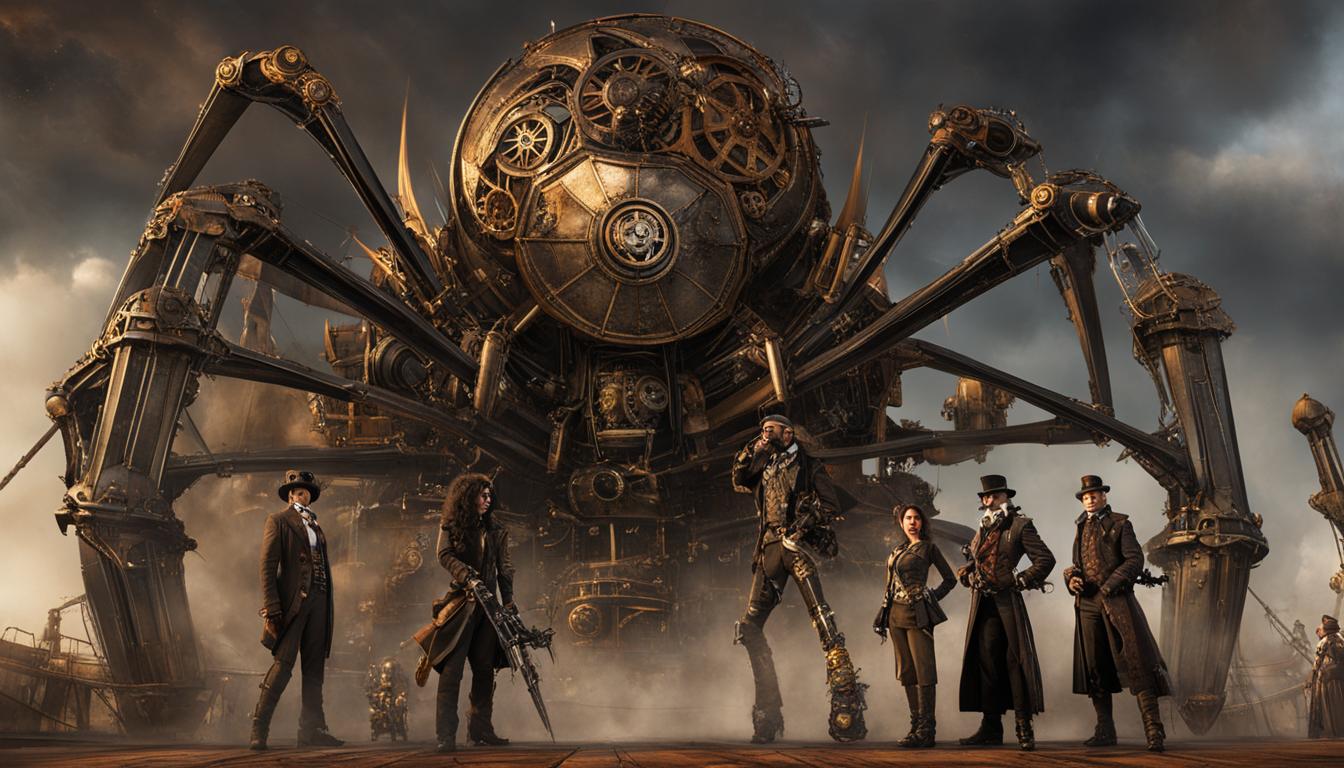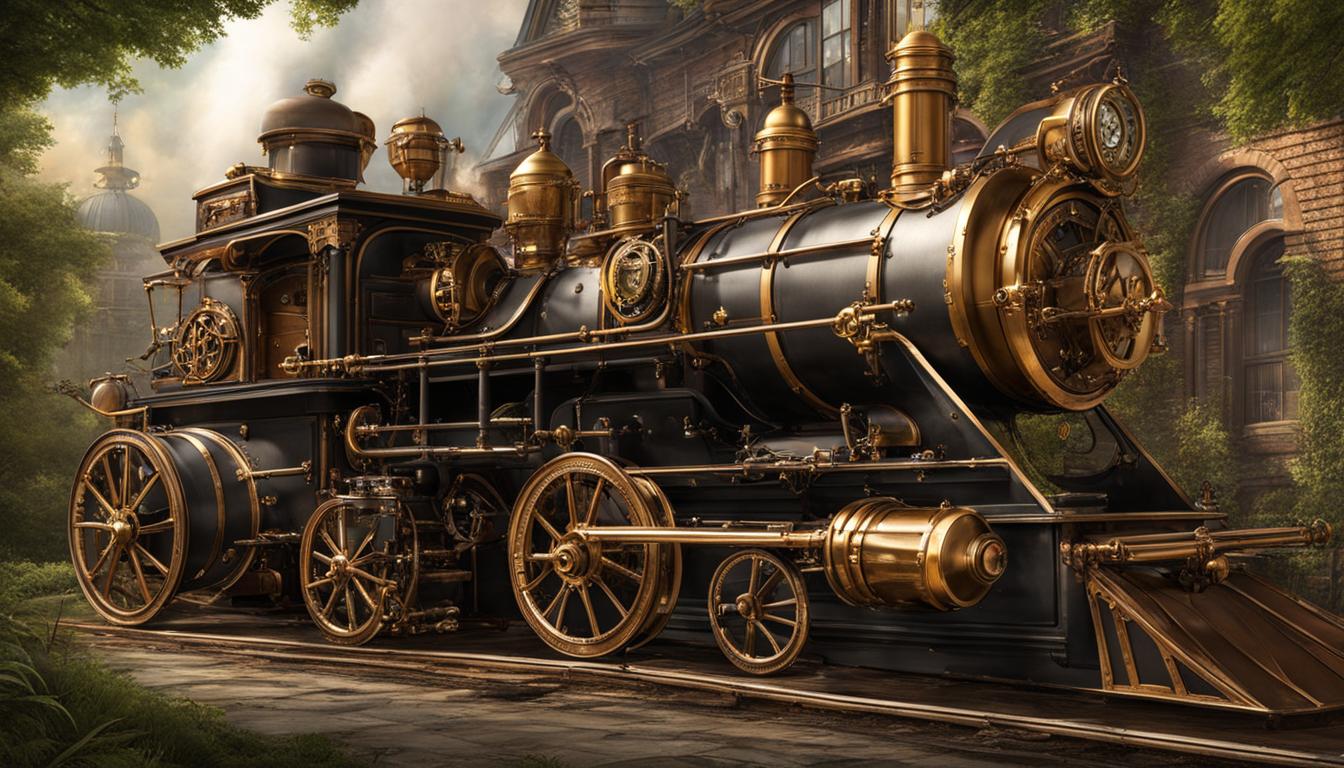Steampunk, a captivating subgenre of science fiction, offers a unique perspective on major historical turning points. By blending the Victorian era with futuristic ideas and steam-powered technology, steampunk authors create alternate histories that diverge from our known past. Through their imaginative storytelling, they re-imagine famous historical events and explore the fascinating possibilities of what could have been.
Key Takeaways
- Steampunk is a subgenre of science fiction that combines elements of the Victorian era with futuristic concepts and steam-powered technology.
- Steampunk authors create alternate histories that diverge from our known past and explore the possibilities of major historical turning points.
- By re-imagining famous historical events, steampunk offers a fresh perspective on key moments in history.
- Alternate histories popular in steampunk provide an intriguing exploration of what could have been, challenging conventional narratives.
- Through their imaginative storytelling, steampunk authors offer a blend of mystery, wit, and informative insights into the past.
The Role of Steampunk in Historical Context
Steampunk is firmly rooted in the historical context of the Victorian era and the Industrial Revolution. It draws inspiration from the advancements in steam-powered machinery and the societal changes brought about by these technological developments. Steampunk authors often explore alternative pathways and inventions that could have emerged during this time period, offering unique perspectives on key events of the 19th century. This subgenre reimagines the industrial revolution with divergent technological advancements, challenging the conventional narratives of history.
Imagine a world where steam-powered airships soared through the skies and fantastical machines powered by clockwork mechanisms revolutionized transportation. In the realm of steampunk, history takes an intriguing twist, offering a fresh perspective on the key events that shaped the 19th century. From the exploration of new energy sources to the reimagination of industrial innovations, steampunk narratives transport readers to a world where the boundaries of possibility are stretched beyond imagination.
“Steampunk offers a captivating fusion of history and fiction, drawing readers into a realm where the Industrial Revolution meets futuristic possibilities.”
While the industrial revolution brought about significant changes in our world, steampunk imagines an alternative reality where technological advancements took a different path. It envisions a world where steam-powered technology remains at the forefront, leading to divergent technological developments and reshaping the course of history. From steam-driven automations to clockwork-inspired contraptions, the steampunk genre breathes new life into the 19th century, inviting readers to explore a realm of wonder and possibility.
| Key Events of the 19th Century with a Twist | Steampunk Interpretation |
|---|---|
| The First Industrial Revolution | A world where steam-powered machinery dominates and clockwork inventions revolutionize society. |
| The American Civil War | An alternate history where steam-driven war machines and advanced weaponry shape the outcome of the conflict. |
| The Exploration of the Wild West | A steampunk frontier where airships and steam-powered locomotives traverse uncharted territories. |
Steampunk’s reinterpretation of historical events and technological advancements offers a fresh perspective on the Victorian era and the Industrial Revolution. Through its unique blend of history and fiction, steampunk invites readers to imagine a world where steam power reigns supreme and extraordinary inventions shape the course of history.
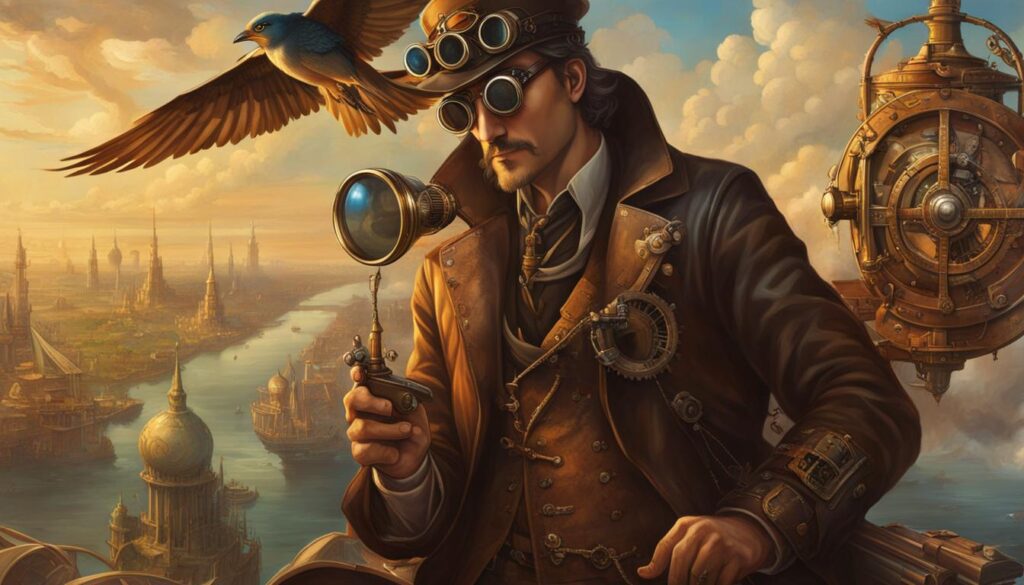
| Famous Historical Figure | Steampunk Interpretation | Inventions/Contributions |
|---|---|---|
| Nikola Tesla | Reimagined as a brilliant inventor and master of electricity, harnessing the power of lightning to fuel steampunk contraptions. | Electrical power generators, tesla coils, and advanced energy transmission devices. |
| Ada Lovelace | Portrayed as a visionary mathematician and computer engineer, exploring the potential of steam-powered computational engines. | Steam-powered analytical engines and mechanical computation devices. |
| Charles Babbage | Envisioned as the mastermind behind intricate clockwork mechanisms and automated devices that revolutionize industry and communication. | Steam-driven mechanical computers, telegraph systems, and automated manufacturing processes. |
“Steampunk allows us to rewrite history with a touch of whimsy, showcasing the remarkable minds of the past in a world fueled by steam and ingenuity.” – Anonymous
Steampunk’s Impact on Alternate Histories
In the realm of steampunk, alternate histories reign supreme. By reimagining major turning points, this subgenre offers a unique perspective on the industrial revolution and its impact on society. Steampunk narratives explore what could have been, presenting divergent paths that challenge conventional historical narratives. With a fascinating blend of Victorian aesthetics and futuristic technologies, steampunk authors transport readers to worlds where steam-powered inventions reshape the course of history.
One of the key aspects of steampunk’s alternate histories is the exploration of turning points. These pivotal moments, whether large-scale events or individual choices, shape the narrative and set it on a distinct path. Steampunk authors examine the consequences of these turning points, both in terms of technology and society. Through intricate worldbuilding and attention to historical detail, these narratives present readers with thought-provoking scenarios that highlight the profound impact that different choices or advancements could have had on the world.
| Steampunk’s Perspective on the Industrial Revolution | Turning Points in Steampunk’s Alternate Histories |
|---|---|
| The industrial revolution is a cornerstone of steampunk storytelling, often portrayed with a twist. While the real-world industrial revolution was driven by coal and steam power, steampunk envisions a world where steam-powered inventions take center stage. This alternate perspective offers a unique lens through which to explore the societal, economic, and technological changes that accompanied the industrial revolution. | Steampunk narratives introduce turning points that diverge from our known history, creating alternate timelines filled with inventions and events that never came to be. Whether it’s a different outcome for a major war or the introduction of groundbreaking technological advancements, these turning points challenge readers to consider the far-reaching consequences of historical choices. |
Steampunk’s impact on alternate histories extends beyond entertainment. It encourages readers to reflect on the complex interplay between technology, society, and history. By examining how different choices or inventions could have shaped the world, steampunk narratives serve as a catalyst for deeper conversations about the relationship between progress and humanity. In a world where the consequences of technological advancements are ever more significant, exploring steampunk’s alternate histories offers a fresh perspective on the ethical dilemmas and potential futures that lie ahead.
Steampunk Themes and Cultural Commentary
Steampunk narratives transport readers to a world where the industrial revolution takes on a whole new meaning. With its unique blend of Victorian aesthetics and futuristic technology, steampunk offers a fresh perspective on the societal and cultural dynamics of the 19th century. Embedded within these imaginative tales are common themes that resonate with readers and provide a platform for social commentary.
One prominent theme in steampunk narratives is rebellion against established norms. Characters often challenge the rigid hierarchies and societal expectations of the Victorian era, offering readers a glimpse into alternative possibilities and inspiring them to question the status quo.
Another prevalent theme is the pursuit of innovation. Steampunk stories showcase the power of imagination and creativity, as inventors and tinkers push the boundaries of what is possible with steam-powered technology. These narratives often explore the intersection of science and art, highlighting the importance of innovation in shaping the world.
“Steampunk is an opportunity to examine history through the lens of retrofuturism, allowing us to explore the consequences of past decisions and the potential for a different future.” – [Author Name]
Steampunk’s social commentary
Steampunk’s unique setting allows authors to comment on social issues and reflect on historical movements. By reimagining the past, steampunk narratives draw parallels to contemporary concerns and provoke thought-provoking discussions.
For example, steampunk often explores themes of social reform, shedding light on the struggles faced by marginalized groups during the Victorian era. These narratives challenge readers to consider the systemic inequalities of the past and contemplate the relevance of those issues in today’s society.
Steampunk’s social commentary extends beyond historical context, addressing modern-day issues through the lens of an alternate past. By blending the familiar with the fantastical, steampunk stories offer a fresh perspective on the complexities of our world and spark conversations about themes such as power, progress, and the human condition.
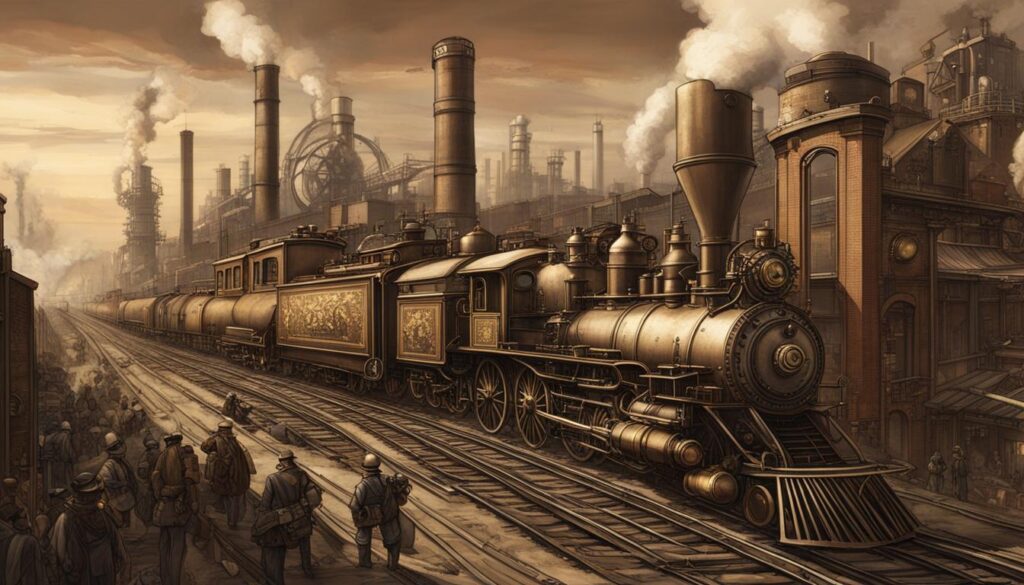
| Common Themes in Steampunk Narratives | Steampunk’s Social Commentary |
|---|---|
| Rebellion against established norms | Challenges the status quo and prompts readers to question societal expectations |
| The pursuit of innovation | Highlights the power of imagination and creativity in shaping the world |
| Social reform | Explores the struggles faced by marginalized groups and sparks discussions about systemic inequalities |
| Commentary on power, progress, and the human condition | Provokes thought on modern-day issues through the lens of an alternate past |
Notable Steampunk Works and Their Themes
Steampunk literature has produced numerous notable works that showcase the diverse themes within the subgenre. These works combine elements of the Victorian era with imaginative technology, offering readers a unique and captivating reading experience. Below are some popular steampunk works and the key themes they explore:
“The Difference Engine” by William Gibson and Bruce Sterling
“In the end, it’s about the difference between the 19th and 20th centuries, and exploring the paths not taken.” – William Gibson
This seminal work reimagines the Victorian era with the creation of a steam-powered computer, known as the Difference Engine. It explores the fusion of historical figures, such as Charles Babbage, with imaginative technology, offering a thought-provoking alternate history where steam-powered computing takes center stage.
“Mortal Engines” by Philip Reeve
“In the future, cities will devour each other.” – Philip Reeve
In this post-apocalyptic steampunk world, cities have become mobile and prey upon each other for resources. The novel delves into themes of innovation and rebellion as the protagonist, Tom Natsworthy, discovers the dark secrets lurking within these mobile cities. It presents a unique take on the future, blending steampunk aesthetics with a dystopian setting.
“Boneshaker” by Cherie Priest
“Steampunk is about taking the technology that’s around you today and making it cooler, weirder, more elaborate and more fun.” – Cherie Priest
Boneshaker combines the gold rush with steampunk engineering, resulting in a thrilling adventure set in a toxic-filled Seattle. It explores themes of adventure, family, and redemption, showcasing the subgenre’s potential for diversity and innovation.
These works and others demonstrate the range and depth of themes explored in steampunk literature. From reimagined historical events to post-apocalyptic futures, steampunk offers readers a chance to experience alternative worlds that challenge conventional narratives and provoke thought on the impact of technology and society.
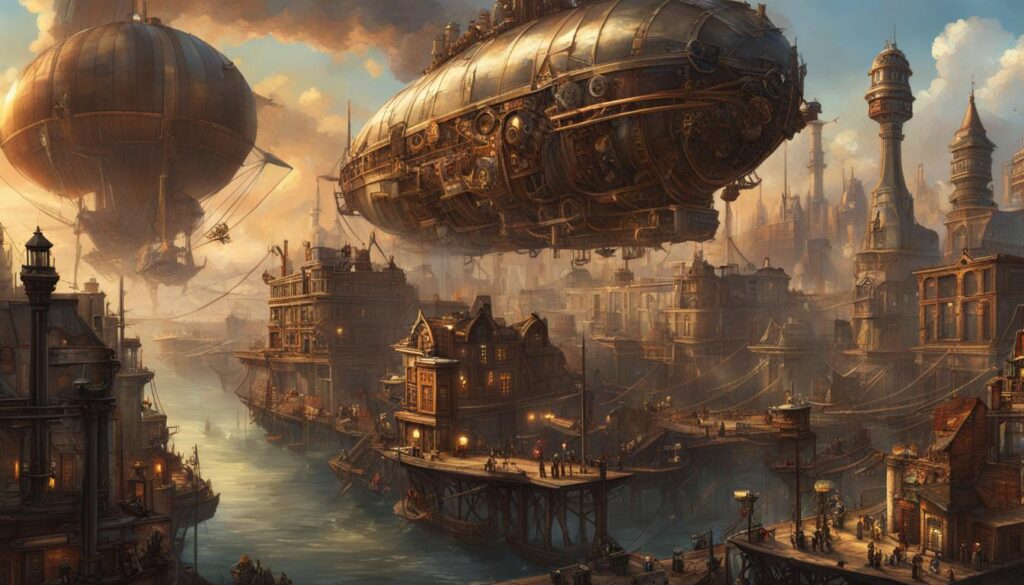
| Book | Author | Key Themes |
|---|---|---|
| The Difference Engine | William Gibson and Bruce Sterling | Alternative history, steam-powered computing, technological advancements |
| Mortal Engines | Philip Reeve | Innovation, rebellion, post-apocalyptic setting |
| Boneshaker | Cherie Priest | Adventure, family, redemption, steampunk engineering |
The Importance of Research in Crafting Steampunk Narratives
When it comes to crafting authentic and immersive steampunk narratives, research plays a vital role. Steampunk literature draws heavily from the historical context of the Victorian era and the Industrial Revolution, blending it with futuristic elements and steam-powered technology. To create a believable world that resonates with readers, authors must have a deep understanding of the societal dynamics, technological advancements, and historical events of that time period.
Research allows writers to integrate historical accuracy into their stories, incorporating realistic steam-powered inventions and exploring alternative historical paths. By investing time in understanding the Victorian era, authors can create narratives that captivate readers with their attention to detail and immersive worldbuilding. From the societal structure to the fashion, from the technological advancements to the political climate, every aspect of the Victorian era can be used as a foundation for building steampunk worlds.
In addition to historical research, authors may also delve into scientific principles and engineering concepts to bring their steampunk inventions to life. By understanding the inner workings of steam-powered machinery and the principles behind fictional technologies, writers can create plausible and engaging inventions that fit seamlessly into their narratives.
Role of Research in Steampunk Worldbuilding
“Research is the key that unlocks the door to immersive steampunk worlds.” – Steampunk Enthusiast
The role of research extends beyond historical accuracy; it is also instrumental in developing the intricate worldbuilding that defines steampunk stories. From the architectural designs of Victorian cities to the atmospheric descriptions of industrial landscapes, research allows authors to create vivid and believable settings. By studying the historical context of the Victorian era and its impact on society, writers can incorporate authentic cultural and societal elements into their narratives.
Furthermore, research enables authors to explore the possibilities and limitations of steam-powered technology, creating a plausible and consistent steampunk world. By understanding the scientific principles behind steam power and exploring the potential applications of steam-driven machinery, writers can develop inventive and imaginative technologies that enhance the story’s setting and plot.
| Key Aspects of Research in Steampunk Writing | Benefits |
|---|---|
| Understanding historical context | Creating believable and immersive settings |
| Studying societal dynamics | Developing authentic cultural elements |
| Exploring steam-powered technology | Creating plausible and imaginative inventions |
Conclusion
Step into the fascinating world of steampunk and unlock the hidden possibilities of history. Through the blending of the Victorian era with futuristic ideas and steam-powered technology, steampunk authors have created a subgenre that pushes the boundaries of historical narratives. By reimagining major turning points and exploring alternative paths, steampunk offers a captivating lens through which to view the past.
But steampunk is more than just a genre; it’s a platform for social commentary and reflection. With themes of rebellion, innovation, and social reform, steampunk stories resonate with historical movements and contemporary concerns. Whether delving into the Industrial Revolution or imagining the impact of key events, these narratives challenge conventional thinking and invite readers to question what could have been.
Research is the cornerstone of crafting immersive steampunk worlds. By diving deep into the historical context, technological advancements, and social dynamics of the Victorian era, authors can create believable and rich narratives. This fusion of history and fiction, with its imaginative inventions and alternative paths, continues to inspire readers and writers alike.
FAQ
What is steampunk?
Steampunk is a subgenre of science fiction that combines elements of the Victorian era with futuristic ideas and steam-powered technology.
How does steampunk reimagine historical events?
Steampunk offers alternative historical narratives where major turning points diverge from our known history, allowing for reimagining famous historical events and exploring alternate paths that history could have taken.
What role does the Victorian era play in steampunk?
Steampunk is firmly rooted in the historical context of the Victorian era and the Industrial Revolution. It draws inspiration from the advancements in steam-powered machinery and the societal changes brought about by these technological developments.
Which famous historical figures are often featured in steampunk narratives?
Steampunk narratives often include reimagined versions of famous historical figures such as Nikola Tesla, Ada Lovelace, and Charles Babbage, showcasing their inventions and contributions to the technological advancements of the era.
What are some common themes in steampunk?
Steampunk often explores themes of rebellion, innovation, and social reform, reflecting the social dynamics and challenges of the Victorian era.
What are some notable steampunk works?
Notable steampunk works include “The Difference Engine” by William Gibson and Bruce Sterling, “Mortal Engines” by Philip Reeve, and “Boneshaker” by Cherie Priest, each exploring different themes within the subgenre.
What role does research play in crafting steampunk narratives?
Research is essential in creating authentic and immersive steampunk worlds. It helps authors integrate historical accuracy, incorporate realistic steam-powered inventions, and explore alternative historical paths.
Why is steampunk a fascinating subgenre?
Steampunk offers a unique perspective on major historical turning points and challenges conventional narratives by blending elements of the Victorian era with futuristic ideas and steam-powered technology. It also allows for social commentary and reflections on the past, present, and future.

